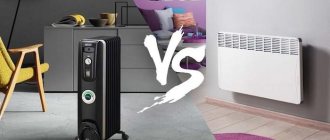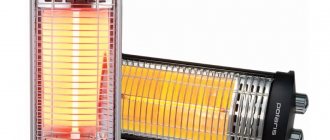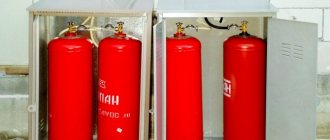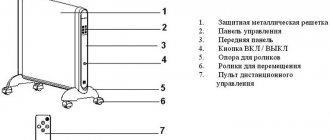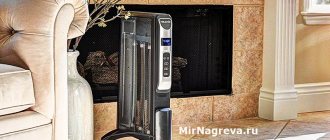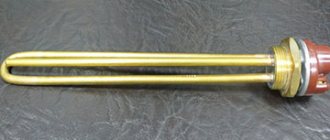General requirements for space heating
The main indicator of any heating device is power. Only a specialist can accurately answer what equipment power is needed to heat a particular room, who will take into account not only the volume of the room, but also a lot of other variables: heat loss through the building envelope, natural leaks, glazing area, number of doors, materials, climatic factors, etc. .
You can independently calculate the required power of heating equipment using the following algorithm: per 10 m2 of heated area, 1 kW of thermal energy is required, provided that the ceiling height does not exceed 3 m .
It should be noted that with this calculation, any device will constantly operate at the maximum of its capabilities, which will negatively affect its service life. Experts recommend making a power reserve: always add a factor of 1.3-1.5 to the calculated value.
Before moving on to discussing the question of which is better, a modern oil radiator or a functional fan heater, you need to have an idea of the design features, advantages and disadvantages of these devices.
How to choose a ceiling infrared heater
Infrared ceiling devices are installed in residential buildings, open areas, greenhouses and factories.
What types of IR devices are there?
IR devices for outdoor and indoor installation are available on the market. Manufacturers produce household and industrial models that differ in appearance, heating temperature and power. There are samples for rooms with high humidity levels (saunas) and with explosion protection.
Ceiling-type infrared heaters are:
- with and without thermostat;
- gas;
- electrical;
- with open and closed coolant.
There are differences in the wavelength emitted by the device:
- shortwave, intended for rooms 6 m high;
- medium wave – for objects 3-6 m high;
- long-wave – installed in rooms up to 3 m high.
Heating elements are:
- carbon (heating occurs due to carbon threads);
- quartz (heating is carried out by a tungsten filament);
- ceramic (the body of such a device does not heat up);
- tubular (heating elements);
- halogen (the coolant is an inert gas located in the tube).
Manufacturers produce low- and high-temperature models. For small rooms, choose dark samples (they do not glow when heated) with low temperatures. For large production areas, light type heaters are chosen. They are used in stadiums, warehouses, and open trading floors.
For greater efficiency of the ceiling-type IR heater, a thermal curtain is installed along with the device. It retains heat and reduces energy losses.
Pros of IR heaters
The efficiency of the devices is 95-98%. The room is heated vertically, in the bottom-to-top direction. Thanks to this, heat fills the room faster, energy consumption is reduced by 5-10% for each degree saved. The operation of IR devices does not require constant human supervision. They are cheap compared to other heating devices. Since ceiling systems are static and contain no moving parts, they require minimal maintenance and no maintenance.
IR heaters also have advantages over other types:
- high heating rate;
- since models of this type do not have fans, they operate silently;
- easy and quick to install;
- do not emit light;
- fireproof;
- it is possible to heat a separate area of the room;
- IR rays have a positive effect on the body.
Minuses
A relatively new type of equipment for heating rooms has a number of disadvantages:
- after switching off, the room cools quickly;
- there is a limitation on the power of the heat flow (if it exceeds 350 W/m², the radiation becomes harmful to the body);
- do not place paintings or objects made of artificial materials in the area of effect of the rays (they can be deformed when heated);
- when purchasing a ceiling device, take into account that the distance from the heating source to the person’s head must be at least 50 cm;
- installation on a ceiling made of materials that are unstable to heat is not allowed.
Subtleties of choice
Depending on the heated area and operating conditions, the number of heaters is calculated. For a small room, one device is installed; for large areas, several are installed. When choosing a model, a number of indicators are taken into account.
- Before choosing a ceiling infrared heater, determine what area it should work on. For industrial, office and warehouse premises with a large area, powerful light-type heaters are chosen.
- An important indicator is the condition of the ceiling. Beams, floors, tension structures must support the weight of the model.
- The ceiling height should ensure normal heat flow.
- Coolant type.
- For installation on the ceiling, choose lightweight models with an aluminum body and film devices.
- The presence of a remote control, an overheating sensor, and a thermostat in the sample. With these devices, servicing the model is simplified.
- Several models are installed over a large area.
If you follow the selection rules, the device will last a long time, and energy consumption will be minimal.
Installation subtleties
Heaters are installed parallel to windows, doors, and external walls. If you plan to install several devices, make calculations to ensure uniform heating of the room.
One heater installed on the ceiling at a height of 2.5 m operates on an average area of 20 m². There are hanging heaters and built-in models on sale.
Operating principle and design of the fan heater
A fan heater is a compact heating device that creates a directed flow of heated air, driving air masses through a heating element. The design of a classic fan heater consists of:
- Housing, which can be made of plastic or metal;
- Heating element;
- Fan of axial or tangential rotation. The former are characterized by their small size and noisy operation. The second ones are larger in size, characterized by silent operation and high productivity;
- Monitoring and control unit.
Fan heater device
According to the design of the heating element, all electric models are divided into three types:
- Spiral;
- Glass ceramic;
- Heating elements.
Spiral heating element fan heater New fan heater Ceramic model
In the first, a nichrome (kanthal, fechral, stainless steel) spiral on a ceramic core is used as a heating element. There are two versions of the spiral heater: open and closed. In the first, the spiral is not protected from external influences, and in the second, the turns of wire are placed in a glass flask. Advantages: fast heating up to 1000 °C, budget cost, good maintainability. Disadvantages: fire hazard, unpleasant odor due to dust combustion on an open heating element.
The glass-ceramic element heats up to only 150 °C, but has a larger area than the spiral. This design solution has a lot of advantages: high efficiency, safety during operation. The disadvantage is the significant cost of glass-ceramic models.
A heating element is a tubular element, which consists of a spiral enclosed in a metal tube. The space between the walls of the tube and the spiral is filled with a non-conducting heat-intensive material. The heating element heats up to 500 °C, which, in comparison with a spiral one, doubles the service life of the device.
The devices differ in the method of execution. Highlight:
- Stationary. Floor, wall and ceiling models;
- Mobile.
Portable and tabletop models. Ceiling fan heater Wall-mounted version Floor-standing model Portable fan heater
Most modern fan heater models are equipped with impressive functionality and additional accessories:
- Rotating base;
- A safety system that stops supplying power to the heating element when it overheats or tips over;
- Thermostat with the ability to maintain temperature in the selected range;
- Humidifier, air purifier;
- Possibility of remote control.
In addition, almost all modern models are equipped with several speed modes that allow you to adjust the fan performance.
Advantages
- Low cost;
- Simplicity of design;
- Compactness (inherent even in stationary models);
- High speed of heating the room;
- Can be used as a regular fan;
- Wide range of models.
Flaws
- Noisiness;
- Directed air flow that can create discomfort and raise dust from surfaces.
According to users, the main disadvantage of fan heaters is the lack of inertia. Heating and maintaining the temperature in the room stops immediately after the device is turned off.
To determine which is better, a mobile fan heater or a stationary heater, you should consider in detail the design and operating principle of oil radiators.
How does a fan heater work?
The fan heater is also not complicated. Here the heat source is a red-hot coil or thin metal plates.
When air is blown, it heats up and enters the volume of the room. The general operating principle is similar to the mechanics of an oil cooler:
- at start, the fan heater reaches its technical maximum;
- voltage is supplied to heat the heat-producing metal parts until the thermostat records the average temperature in the case specified by the user;
- There is no complete cessation of energy consumption - the fan runs constantly.
But there are also key differences between the two classes, which will be mentioned later. Here we note the main thing: the fan heater is strongly tied to the air flow; if it is impossible to supply the full volume for blowing, the device will turn off due to internal overheating protection, releasing noticeably less heat into the room than stated by the manufacturer. A covered fan heater will not be able to “survive”, unlike an oil radiator.
Operating principle and design of oil heater
This device is a sealed steel container with a heating element filled with transformer oil (“spindle”). Heating is controlled by a thermostat. The design of this device includes the following elements:
- Capacity. It can be in two versions: flat panel, in the form of a radiator;
- Heating elements. Most models have heating elements installed;
- Oil, which plays the role of a coolant with a high heat capacity coefficient and a long cooling period;
- A control unit that includes a thermostat, temperature controller, and power switch.
Oil heater device
The operating principle of the device is based on the phenomenon of convection. After voltage is applied to the device, the heating elements begin to heat the oil that fills the radiator. When the user-defined temperature is reached, the thermostat turns off the heating elements. After the temperature of the coolant drops by several degrees, the heating elements turn on and reheat it to the set temperature.
Depending on the mounting method, all oil radiators are divided into the following types:
- wall;
- floor;
- desktop;
- ceiling;
- for cribs.
Floor-standing model Unit with built-in fan Wall heater
To increase the speed of heating the air in the room, some models are equipped with a fan that evenly distributes the heated air masses.
Advantages:
- Large heat transfer area due to the shape and size of the container;
- Silence. These devices (except for models equipped with a fan) do not have mechanical components;
- Environmentally friendly. The devices do not affect the quality characteristics of the air and do not emit unpleasant odors;
- Safety. Thanks to the sealed container and relatively low surface heating temperature, such devices are completely safe to use;
- Economical. The high heat capacity of the coolant allows heating elements to be turned on rarely, which significantly saves energy;
- Reliability and durability. There are no moving parts in the device, so, in principle, there is nothing to break. The sealed tank does not allow oxygen to interact with its internal surface, which eliminates the effects of corrosion.
Flaws:
- Long initial heating time.
- Heavy weight. This drawback is not critical, since each floor-standing model is equipped with wheels for easy movement.
Infrared or oil?
After being plugged into a power outlet, infrared heating devices instantly heat everything in the area affected by the IR emitters: walls, floors, furniture, people. The warmth from it is pleasant and comfortable. If dangerously approached, it may cause the object to catch fire. It must be installed safely.
Oil-based appliances are safer to use. Models with a tubular frame have protection against contact with hot ribs. Expensive lamps, like those of an IR device, will not need to be changed on such a device.
Conclusion:
- An IR heater is worth choosing to save the family budget and as a local heat source for instantly heating the workspace.
- An easy-to-maintain oil appliance is preferable in families with small children and pets. There will be no difficulties in choosing an installation location.
Oil or fan heater?
The oil device does not produce heat immediately, but distributes it evenly throughout the room. Electricity consumption is the same as that of a fan heater.
A stream of narrowly directed warm air comes from the fan heater. Therefore, you can warm up instantly after turning it on. You'll have to put up with the noise and not be outraged when the electricity bill comes.
Conclusion:
- Oil equipment is suitable for constant heating and creating a comfortable indoor microclimate for a long time.
- It is better to use a fan heater for a short time, in small rooms, for a small service area.
Comparison of fan heater and oil heater parameters
To understand whether it is better to purchase a heater or a fan heater for heating a room, you need to compare the parameters and characteristics of these devices.
Power consumption
The fan heater must be constantly running to heat and maintain the air temperature within the specified parameters. In other words, this device constantly consumes electricity.
The oil radiator operates for a strictly defined time, after which it turns off and releases the accumulated heat to the air. In other words, this device operates intermittently.
Oil cooler is more economical
If we compare electricity consumption between devices with the same power, then the economical oil heater wins in this category by a significant margin.
Heating speed and quality
Thanks to the forced distribution of air, the fan heater quickly creates a comfortable temperature in the room being served. As for quality, not everything is so clear. To maintain temperature, the air must be in constant movement. A jet of hot air creates a feeling of warmth only near the heating source.
An oil heater of a classical design, on the contrary, takes a long time to enter operating mode, but after that it stably maintains the temperature in the room, without creating drafts or raising dust.
According to these indicators, parity has been established between the devices.
Life time
The service life of a fan heater is 3-5 years, and this is only with regular maintenance. Fan mechanisms are subject to wear, heating elements fail and become overgrown with carbon deposits.
Heating elements quickly fail due to carbon deposits
The only thing that can affect the service life is depressurization of the oil container due to a fall or mechanical damage. If the operating rules are followed, the average service life of an oil radiator is 10-15 years.
Tip: oil-based heaters are much more durable.
Noise level
Proponents of using oil heaters claim that their favorites are completely silent, while fan heaters make a very loud noise. In fact, everything is wrong: both fans and heaters make sounds. In the first case, this is the sound created by the blades overcoming air resistance, in the second - clicks and crackling, characteristic of metal expanding when heated.
Neither one nor the other device can be called completely silent.
Reliability
The heating elements of the fan heater gradually burn out. The lubricant, which reduces the coefficient of friction between the fan elements, dries out over time. The contact group is subject to oxidation due to exposure to moist air. Based on this, the assertion about the reliability of these devices can be questioned.
Heaters with coolant oil do not have rotating parts that are subject to wear. The only thing that can “kill” a good heater is power surges, which can lead to failure of the electronics.
A fan heater is not the most reliable device. An oil radiator is practically “indestructible”
Attention! In terms of reliability, heat fans are significantly inferior to their “oil” opponents.
Modes
All modern heating devices are equipped with the ability to operate in several modes. As a rule, this is 50 and 100% power. Almost all fan heaters can operate in ventilation mode (without heating). For oil heaters, this feature is present only in models with a built-in fan.
Almost all fan heaters can operate in ventilation mode
Safety
Most heat fans in the household segment are equipped with plastic and very light casings, which crack and shatter into their component parts when dropped, exposing current-carrying elements and a hot heater. Advanced models are equipped with a position sensor that will de-energize the device if it falls. Most models in the budget segment do not have such a security system.
An oil heater is a steel, large and heavy device that is very difficult to drop or break. However, the surface of the body of most models is not protected from touch, which makes it possible to get burned.
Fan heaters often have a plastic casing Oil heaters are made of steel
Microclimate
What creates a healthier microclimate, an oil radiator or a household fan heater? There is an opinion that fan heaters dry the air and burn out oxygen, which is far from the truth. The devices do not have an open flame, the combustion of which is maintained by the combustion of oxygen. This is due to the moisture capacity of the air, which increases as the temperature rises. If there is a source of water in the room, the air will “pull” water vapor from it, and the humidity will increase. If there is none, then the person himself becomes the source of moisture. Hence the feeling of dryness, drying out of the mucous membranes, skin, etc.
A comfortable indoor microclimate is created thanks to the required air temperature, humidity level (40-60%), and proper air exchange (1 time per hour). Both devices, when properly placed and adjusted to the operating mode, are capable of creating a comfortable microclimate in a heated room. Another thing is the smell of burnt dust, which settles on the heating elements of the air heater, and the air flow, which can cause discomfort to people in the room. Oil heaters do not have such problems.
Price
The price of heaters depends on the power of heating elements, functionality, degree of safety and brand. Today, an oil radiator can be purchased from 1,500 rubles. The cost of electric fan heaters starts from 500 rubles.
A fan heater costs from 500 rubles. The price of an oil radiator is from 1500 rubles.
Round one. Comparison in terms of price and convenience
The first thing the user evaluates is the ease of use of the electrical device and its safety. For the average potential owner, this assessment is enough to decide what is better to buy - a fan heater or an oil heater. In this case, energy consumption and the cost of long-term operation are not taken into account. Therefore, let's make a direct comparison.
- Noise level. Pure loss of the fan heater. Although modern models are equipped with horizontal fans or screw turbines, the noise level is significant. The fan heater does not stop, this contributes to the development of fatigue, decreased concentration and attention of a person. In addition, as use progresses, the device becomes dirty and begins to make more and more noise.
- Switching modes. To be as precise as possible, both classes of heaters make clicking and crackling noises. But with a high-quality oil heater, uncomfortable noise occurs only when, for example, it was stored upside down or lying down. Once installed in a vertical position, the gurgling and crackling time is short, the device quickly enters the mode and the only sound that is emitted is the soft start-up clicks made by the thermal relay. The fan heater clicks loudly with relay groups much more often. In this case, a high voltage is switched, the sound is distinct and quite loud, in addition, in many models the fan motor speed simultaneously increases.
- Overall reliability. Device failures play an important role, and here the fan heater is an outright outsider. It has two temperature protection groups, the heaters are subject to constant burnout, the fan group is subject to depletion of lubricant, and the regulators are subject to oxidation and drying out. A good oil cooler has only two bottlenecks. A bimetallic plate in the regulator, which will oxidize or burst after ten years, as well as a universal temperature and pressure fuse - in case of any problems associated with overloads and loss of oil pressure, it blocks the operation of the device and must be replaced.
- Safety of use. The fan heater is lightweight and is often not equipped with a position sensor. It is easy to brush away, drop, break. However, there is no guarantee that it will stop working. And this causes an additional possibility of fire of objects, short circuits, and electric shocks. The oil cooler is durable, heavy, solid. It is difficult to drop it, damage it, or touch other objects with it. But the heated elements of the fan heater are covered with grilles, and you can touch the oil radiator heating block with temperatures up to 90 degrees. Therefore, in terms of safety of use, both classes have their own niches, where each of them is able to win.
- Microclimate. The fan heater plays with a loud crash. It burns oxygen. In addition, dust is constantly sucked into it, burns in a spiral and emits an unpleasant odor. The oil cooler has no problems. Modern models equipped with a humidification unit can improve the microclimate, including saturating the air in the room with aromatic oils.
- Humidifier attachment can be used to dry clothes. Comparisons can continue for a long time. The undoubted advantages of oil radiators and the gains in many areas are visible during operation. But when choosing a model in a store, the fan heater wins; it is cheap, lightweight, compact, and you can buy a model of any power.
Recommendations for selection
What to choose for heating a living space during the off-season, a bulky oil heater or a compact fan heater? The choice depends on the conditions in which the equipment will be used:
- If you need to periodically and quickly raise the air temperature in a small room, and the noise emitted by the fan does not matter, then you can give preference to a heat fan. If you need to maintain a constant temperature in your living space, then pay attention to heaters with coolant oil;
- When choosing a fan heater, pay attention not only to the power of the heating elements, but also to the performance of the fan. It should be equal to twice the volume of the heated room, so that it is possible to ensure uniform distribution of air masses and ensure rapid heating of the home;
- If the oil heater has large dimensions and low weight, then the manufacturer has saved on materials, which can significantly reduce the service life of the device;
- Give preference to models that consist of 6-8 sections. This is enough to heat medium-sized rooms.
And one last thing. The presence of a timer on any heating device will allow you to program the device on and off, greatly simplifying its use.
Watch a video about testing different types of heaters
Selecting a heating device
The right choice of heating device will bring warmth and comfort to your apartment.
As you can see, oil convectors are leaders in many indicators, but fan heaters occupy a very specific stable niche among heating devices. To finally choose a specific heating device, watch video reviews on this topic.
Selecting a fan heater
Can the heater be used in any office?
No. The Ministry of Emergency Situations does not prohibit doing this, but the owner of the premises can.
“The main thing is that the device is certified and works properly, and that its owner follows the rules, and then firefighters will not have any questions,” explains Olga Melchenko, official representative of the Minsk City Department of the Ministry of Emergency Situations. “However, the owner of the premises has every right to restrict the use of such devices. Specialists develop instructions on the basis of which operating conditions are introduced. It covers issues of smoking, storing hoverboards, using heaters, and so on. Technically, this can be resolved by contractual relations between the tenant and the landlord. So such issues must be resolved on a case-by-case basis.
The Ministry of Emergency Situations asks you to remember about fire safety measures and not to forget about simple but important rules.
Types of heaters
Today on the market there are a great variety of different electric heating systems, from simple small heaters to complex systems of heated floors, walls or ceilings with remote control coupled with smart home systems, but all of them can be divided into just a few types:
- Electric (fan heaters)
- Electric fireplaces
- Oil radiators
- Convectors or convection heaters
- Quartz panels
- Infrared. They differ by type of heating element: halogen, carbon, quartz, micathermic (best efficiency)
Convectors - operating principle, advantages and disadvantages
The operating principle of the device is based on the ability of air to heat up under the influence of natural convection. Air from the room penetrates the equipment, warms up to a comfortable temperature and flows outside. The air flow fills the entire volume of the room through natural processes.
Convectors are classified according to the type of energy used:
- electrical equipment is the easiest device to operate, since its operation requires only a source of electricity and a competent choice of power;
- gas equipment - the operation of such a device is cheaper compared to its electric counterpart, but the cost is slightly higher. The connection process is complicated, since a gas line is required.
According to the method of placement, convectors are divided into three groups:
- floor-mounted – the design includes wheels for greater mobility;
- wall-mounted - in this case, for better heating of the room, the device is mounted a few centimeters above the floor;
- combined - such models can be installed in any area of the room.
Convectors are equipped with two types of thermostats - electronic and bimetallic. Thanks to this device, the room temperature remains constant for a long time. It is better to give preference to models with an electronic thermostat, which clearly demonstrates the temperature in degrees Celsius. The calibration of bimetallic thermostats is less clear, as it is presented in conventional units.
Advantages and disadvantages of convectors
- Long period of continuous operation.
- Possibility to choose the installation method indoors.
- The presence of thermostats through which the temperature regime is adjusted.
- Several devices can be combined into a heating system for the entire building.
- The equipment is safe.
- The device operates silently.
A significant drawback of convector devices is the slow heating of the air, this is explained by the limited capabilities of natural convection.
The best brands: Ballu, Polaris, ADAX, NeoClima, Electrolux, Stiebel, Eltron, Timberk, Nobo, Termor, Noirot.
The best choice is models equipped with a thermostat that determine the room temperature with an error of no more than one degree.
Comparing operating principles
A fan heater or heat gun transfers heat using indirect heating. That is, the fan heater heats the air, and the heated air heats the surrounding objects. Obviously, warming up this way will take more time.
Comparison with a heat gun
The IR heater uses direct heating. Infrared rays or thermal radiation directly heat objects that surround the heater.
IR heaters are available for wall, floor and ceiling. Infrared heaters can also be used for local heating in a large room. But, it is worth remembering that a person’s long stay in front of an IR heater causes discomfort and dryness on the skin.
Also, the temperature of the heating element of an infrared heater is very high, so its use in rooms with a high fire hazard is not recommended.
What do fans look like in the interior?
Among the disadvantages of the fan heater, it can be noted that it dries the air and creates noise during operation
Therefore, when choosing a model, pay attention to the noise during operation. Modern medium-power models should have a noise level no higher than 25-30 dB
Both types of heating devices are best used in rooms where people are not constantly present. For example, a warehouse, utility room, garage, etc. We talk about choosing a heater for the home in the corresponding article: “Choosing a heater for the home.”
Below in the table we have summarized the main advantages and disadvantages of both types of devices.
| Fan heater vs infrared heater | |
| Flaws | |
| Noise | Dries the skin and mucous membranes |
| Dries the air | High temperature of heated surface |
| Potential fire hazard | |
| Advantages | |
| Low cost | Feeling of natural warmth |
| Warm-up speed | Possibility to warm up part of the room |
| Can be used outdoors |
Features of using heating devices
Fan heaters and convectors are often purchased for apartments in high-rise buildings, but sometimes they are also needed in houses. In an apartment, the heater serves as the main heating system in cold weather, and in a private house the owner can use it as an additional and/or alternative heating system.
The devices are also installed in rooms that require special temperature conditions (children's rooms, bathrooms, etc.).
Fan heaters are ideal if you need to quickly warm up the air. They are indispensable in the cold season at dachas, garages, workshops, etc. Convectors require more time, but their operation is more stable and energy consumption for heating is less
The basis for a meaningful choice of any device is an understanding of the principle of its operation, design, disadvantages and advantages. There is no ideal and universal technology, so you need to figure out which models are best suited for specific operating conditions. You should also decide on your own needs, priorities and expectations.
What is a heater for?
To choose the device that best suits you, it is important to decide what you need it for. This way you can determine what type of equipment will suit your purposes. For example, to heat an apartment for a long time, it is best to use an oil heater, which is fireproof, quiet and relatively economical.
Convector heater device.
For those who have small children at home, we can recommend convector heaters, which can be placed in a place inaccessible to them, for example, hung on the wall. You can control such a device using the remote control. Such equipment will be combined with any interior, but its disadvantage is the lack of mobility.
Traditional spiral or karmic fan heaters are suitable if you need to warm up the room quickly but not for long. The cost of such devices is low, but they provide quick and high-quality heating of the room due to the fact that the air is dispersed throughout the room. However, spiral fan heaters do not fully comply with fire safety standards. It is strictly forbidden to leave them unattended.
Return to contents
Common areas: safety and essentials
Safety is everything for a heater. Therefore, automatic shutdown in case of overheating and a tilt sensor are absolutely necessary for automatic shutdown when tipping over. Automatic shutdown before overheating is either a temperature sensor that opens the electrical circuit when the heating element reaches a certain maximum, or an air overheating sensor at the outlet: if the air outlets are blocked (the towel is dried on them, despite the prohibitions), the device will turn off. Another important function is the presence of an anti-freeze mode, when the heater maintains a room temperature of about 5-7 degrees Celsius. This is not enough for a person, but it prevents freezing of the water supply, central heating pipes (when it is turned off), sewerage, cellar, etc. This function is not found in inexpensive fan heaters, but in convectors and oil heaters its presence is essential. Everything else - type of control (electronic or mechanical), display, timer, number of sections (for oil-based devices), remote control, programming ability, presence or absence of a built-in humidifier, ionizer or dust filter - questions of need for a specific user and willingness to pay for the extra function.
There is one more nuance: if you need a heater for use in a bathroom, sauna, or basement, where condensation often occurs, then it is better to choose a model with a waterproof housing.
Heater with waterproof body for bathroom
